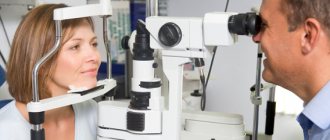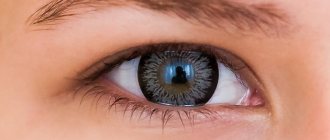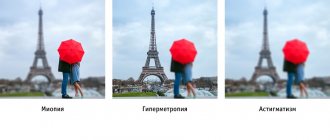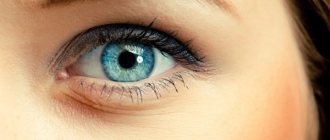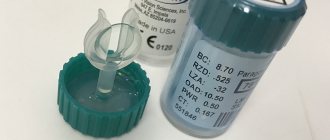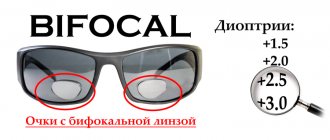Age-related farsightedness is a type of ametropia that occurs after 40 years. This defect is corrected with glasses or contact lenses that are equipped with 2 or more optical centers. Some people develop presbyopia when they have myopia or hypermetropia. Let's find out which correction means are suitable in this case.
After 40 years, all people begin to develop presbyopia, which is characterized by deterioration of near vision: it becomes difficult to distinguish small objects at close range. Therefore, this refractive error is also called age-related farsightedness. It is impossible to avoid it. The development of the defect is associated with the aging of the body. The lens loses its elasticity, and the ligaments and eye muscles become less elastic.
For some people, the first signs of presbyopia appear around the age of 40, for others - a little later. The main symptom of the defect is decreased near vision. A person has to move objects, such as a book, away from their face in order to see it better. Reading glasses are required, that is, with “plus” diopters.
What lenses are used for farsightedness?
Farsightedness, also called hyperopia, is corrected using optics with positive diopters. This applies to both ordinary hypermetropia, a pathological visual impairment, and presbyopia, an age-related deterioration of visual functions. With farsightedness, a person has difficulty seeing close up. The refractive system of the eye is weakened or the eye has an irregular shape. Because of this, the image is formed not in the center of the retina, but in a plane behind it. When a person looks directly at objects distant from him, he does not experience any discomfort, but as soon as he turns his gaze to objects located close, the image blurs. To make it clear, it is necessary to increase the refraction. For this purpose, “plus” optical products are used. With myopia, the opposite picture is observed. A person sees blurredly into the distance. To compensate for this refractive error, ophthalmic products with a “minus” value are required.
At first glance, everything is quite simple. After diagnosis, a person must understand what lenses to wear. However, when selecting optics, many nuances are taken into account, which determine the quality of correction and the comfort of using the optics. In turn, the health of a person’s eyes depends on the quality of vision and the comfort of wearing correction products. We will find out what lenses children and adults should wear for farsightedness, how “plus” lenses are used correctly, and also which optics is better to choose - glasses or contacts.
Types of intraocular lenses
Intraocular lenses (IOLs), depending on the number of foci, can be monofocal or multifocal.
- Monofocal IOLs have one focus to provide distance vision only, then glasses are selected for near vision.
- Multifocal lenses have several focal points, which allows the patient to do without glasses and provides good vision both near and far. Multifocal or “pseudo-accommodating” lenses have a particular advantage over traditional lenses. The special design of the optical part of this lens (mixed diffractive-refractive nature of the optics) allows you to imitate the work of the natural lens of the eye. Having not one, but several focuses, multifocal lenses allow you to achieve maximum visual acuity, both near and far, and also significantly reduce a person’s dependence on glasses or, in the vast majority of cases, get rid of them altogether.
- Multifocal toric IOLs - lenses that combine all the advantages of toric and multifocal lenses, can eliminate astigmatism and the need to use glasses altogether.
Other types of modern soft intraocular lenses (IOLs):
- With yellow filter: to protect the retina from the blue spectrum of sunlight, without changing the perception of other colors. As a filter, the lens acts like a person's own lens.
- Aspheric: they do not have the disadvantage of traditional intraocular lenses, when installing them it is impossible to avoid aberrations due to their incomplete correspondence to the human eye. The aspherical surface and other manufacturing features allow for higher quality images on the retina, especially in low light conditions.
- Toric lenses: a new life for patients with cataracts and astigmatism. Toric lenses have different refractive powers in the desired areas and provide good correction of distance vision, almost completely replacing the function of the removed lens and relieving the patient of corneal astigmatism.
What lenses should children wear for farsightedness?
Hypermetropia in children is the norm in the absence of progression of the pathology. Children's eyeballs are smaller than adults'. Because of this, light rays cannot converge on the central point of the retina to form an image. It ends up right behind the retina. In childhood, hypermetropia may not be felt if it is not pathological. Over the years, vision improves. Already by about 14 years of age, the refractive error may completely disappear. Sometimes this happens by age 18. In this regard, patients under 18 years of age are not prescribed laser correction. If farsightedness has non-physiological causes, it must be treated.
The selection of lenses for farsightedness is somewhat different from the selection of optics for adult patients. This applies to both spectacle optics and contact optics. Children are not prescribed optical products with a power that fully compensates for the refractive error. The lens power should be slightly less than the actual number of diopters diagnosed in a small patient. If a child has numerical vision of +4 diopters, he needs lenses with a power of +3 diopters. This stimulates the work of the eye muscles.
Optics for children are prescribed only for moderate and severe degrees of farsightedness. Lenses are not required at the initial stage of pathology development. If your vision is severely impaired, spectacle lenses must be worn at all times. This helps stop the development of pathology.
How to maintain clear vision after 40
Even if the symptoms of presbyopia have already appeared, you can stop the deterioration of your vision by systematically performing exercises. To restore normal vision, you should learn to keep your eyes in a relaxed state, and also strengthen the oblique muscles of the eyeballs.
It will be useful to read at as close a distance as possible, first with one eye and then with the other. You need to zoom out and zoom in on the text several times. For age-related farsightedness, it is much more effective to train in reading small print than to wear glasses.
By the age of 45, most people can no longer clearly see small details located at a distance of 30-35 cm. This is observed even with healthy eyes. You can check for age-related farsightedness in this way: sit so that your palm can fit between your chest and the edge of the table, place your elbows on the table, and place your fingertips on your temples. In this position, the optimal reading distance is achieved.
If you want to preserve your vision as long as possible, you need to read only at this distance. When, when following this rule, it becomes difficult to distinguish the text, it means presbyopia has begun to progress. But this is provided that there are no other refractive errors.
Any exercises should be done without tension, avoiding eye fatigue. You can let your eyes rest by simply closing them. This helps relieve tension in the eye muscles.
What lenses should adults wear for farsightedness?
In adults, hypermetropia can be treated with laser surgery. However, not everyone decides to undergo such a procedure. In addition, for some it is contraindicated. Such patients cannot do without correction means. For adults, lenses with an optical power equal to the actual refractive error are selected. For +5 vision, optical products with appropriate diopters are used for correction. The initial stage of farsightedness does not need correction. Refractive errors are compensated by the accommodative abilities of the eyeball. Only after 40-45 years, when presbyopia develops, even with mild hypermetropia, you have to wear plus lenses for reading.
If you have moderate farsightedness, you should wear lenses only when reading and working at the computer. If vision is severely impaired, glasses are worn almost constantly.
Selection
An ophthalmologist selects lenses. A detailed examination of the eyeball is carried out, then the optimal means of vision correction is selected. The doctor will prescribe CLs in which the patient will be comfortable. For correct selection, visometry, ophthalmoscopy, accomodometry, and refractometry are performed.
A fundus examination is carried out on a wide pupil, and intraocular pressure is checked.
When selecting contact forces, the following criteria should be taken into account:
- optical power;
- water content;
- base curve;
- duration and mode of wearing;
- oxygen permeability;
- tensile strength.
After choosing a lens to correct farsightedness, the patient tries on the contact lens with a doctor. In it, the doctor checks visual acuity, the patient walks with it for 2 hours.
If the user noted comfort, lack of dizziness and distortion of objects, the doctor gives a prescription for the purchase of lenses with the necessary parameters, a certain wearing mode and replacement period.
What to choose for hypermetropia - glasses or contact lenses?
Before the age of 7-8 years, children are usually prescribed glasses, since contact lenses are more difficult to use. After 7-8 years, it is easier to explain to a child how to properly put on and take off contact lenses and care for them. Then you can transfer the patient to contact vision correction. They do not limit when playing sports, which is especially important in childhood. They are also preferable psychologically. Many children are embarrassed to wear glasses.
An adult decides for himself which method of correction suits him best. It is worth considering many factors when selecting optics. Thus, a high degree of farsightedness is better corrected by lenses. Glasses with a large set of diopters are quite difficult to wear. Of course, a lot depends on physiological characteristics, but ophthalmological practice shows that glasses with optical power designed to correct a high degree of hypermetropia cause discomfort in patients in the form of headaches and eye pain, pain in the eyes, and increased fatigue.
Another important nuance is a person’s lifestyle. If you spend a lot of time driving, it is better for you to wear aspherical contact lenses. They have a more complex geometry, due to which all distortions are eliminated. In addition, aspherical contact lenses prevent glare and halos in the dark, and also guarantee high image contrast. You can also choose aspherical spectacle lenses. However, they have a significant drawback - limited fields of view. Aspheric contact lenses do not have this disadvantage.
Treatment of farsightedness
The final treatment method is determined based on the causes of hypermetropia and the degree of impairment. There are conservative and surgical treatment options.
Conservative treatment
Conservative treatment as such is not aimed at eliminating farsightedness, but at alleviating the patient’s condition and eliminating asthenopic symptoms.
First of all, this includes effective vision correction. The patient is prescribed “plus” glasses or contact lenses. Depending on the degree of impairment, glasses/lenses may be prescribed for constant wear or for close-range work only.
If we are talking about moderate hyperopia or presbyopia, office or progressive lenses that have several optical zones, for example, near and far zones, can be prescribed for correction.
Hardware treatment
has proven itself in the fight against this violation. People with farsightedness may be prescribed electrical stimulation, physiotherapy, and ultrasound methods. Vitamin courses are often used to improve visual tone.
For farsightedness, a course of hardware treatment may be prescribed
These methods are unable to completely cure the disorder, but they can slow down or even stop the further development of the disease and alleviate the condition of a person with farsightedness, providing him with comfortable visual conditions.
Surgical methods for treating farsightedness
Laser correction is a common method; the procedure is fairly quick and is considered minimally invasive. The operation is performed using local anesthesia, and the patient is sent home the same day. However, this method has a number of limitations, for example, laser correction is not performed if the patient has a significant impairment of accommodation.
In severe cases, refractive lens replacement is possible. Phakic lens implantation is also used.
How to choose lenses for farsightedness?
Spectacle and contact lenses must be fitted at your ophthalmologist's office. The optical power of glasses is determined as follows. The doctor determines the patient’s visual acuity using a special table. After this, the ophthalmologist offers the subject optical glasses, with the help of which he examines the optotypes in the desired row of the table. If the lenses are not suitable, the doctor gives you other products with a larger range of diopters.
When selecting contact lenses, visual acuity is determined using a table, after which computer research methods are prescribed. The final stage of selection is the fitting of contact optics.
Features of daily contact lenses
This type of contact optics is convenient and extremely safe. Disposable models are the most hygienic, as they do not require maintenance. After removal they are disposed of. There is no need to waste time on disinfection. There is also no need to purchase solutions and a container for storing contact optics. The only “minus” of daily lenses is their high price compared to other ophthalmic products. This disadvantage is compensated by the numerous advantages of daily lenses described above.
Ochkov.Net 1-Day, Ochkov.Net 1-Day Premium. These lenses are produced by the most famous companies specializing in contact products. It is approved by experts and liked by customers.
Clariti 1 day toric. They can correct farsightedness, nearsightedness and astigmatism.
What lenses are needed to correct age-related farsightedness?
With presbyopia, the patient needs reading lenses, that is, optical products with positive power. Presbyopic glasses are usually equipped with a power of +0.75-+1 diopters. After a few years, the diopters will need to be adjusted by about 0.5 diopters. This happens until the age of 60-65. At this age, you will need lenses with an optical power of +3 diopters.
If presbyopia develops against the background of hyperopia, the power of presbyopic lenses is added to the optical power of glasses to correct farsightedness. So, for example, if a patient wore glasses with a power of +4 diopters, he needs to add another 0.5 diopters to them.
For myopia, the patient will need two pairs of glasses, since “minus” optics are used for myopia, and “plus” optics for presbyopia. Some glasses correct presbyopia, while others correct myopia. Two pairs of glasses can replace frames with bifocal glasses, which few people like from an aesthetic point of view, or multifocal contact lenses with several optical zones for correcting myopia and presbyopia. Multifocal contact optics are also suitable for people who are concerned exclusively with presbyopia, not burdened by myopia or hypermetropia.
Presbyopia
Presbyopia is an ophthalmological pathology that develops in people over 40 years of age. This is age-related farsightedness.
Presbyopia means difficulty focusing your vision at close range, but not compensating for it at distance.
Age-related hypermetropia is treated in several ways, using refractive surgery and lenses to correct this visual abnormality.
Types of CL used to treat presbyopia:
- Multifocal products are called progressive. For presbyopia, CLs are prescribed to ensure an ideal fit. Multifocal optical products are selected by the doctor individually for each patient after a thorough examination.
- Bifocal lenses are an innovative option for correcting age-related farsightedness. The upper part of the optical product is designed for distance vision, and the lower part is for near vision.
Contact optics are based on innovative materials with high oxygen permeability and optimal moisture content. Selecting a CL is not difficult, since most models are designed to correct age-related farsightedness in increments of 0.25 diopters.
Where to buy lenses to correct farsightedness?
If you have a prescription in hand or you know exactly what lenses you need, you can buy them in any salon or online store. You will find a large selection of ophthalmic products for the correction of hypermetropia and presbyopia on the Ochkov.Net website. Among lenses with multifocal design, Oasys for Presbyopia, Biofinity Multifocal, Proclear Multifocal are in great demand. If you need aspherical lenses, pay attention to the following models: monthly Air Optix Aqua, daily Dailies AquaComfort Plus and Proclear 1 Day and color Adria Glamorous.
In our store you can not only buy optics, but also find out answers to many important questions: how to use lenses correctly, care for them, what solutions are best to purchase, etc.
The thinner the lens, the more expensive it is
Single vision spectacle lenses differ from each other not only in design. For their manufacture, different optical materials are used, which, in turn, have different refractive index values. Based on the value of the refractive index (+n), all optical materials are divided into groups:
- with normal refractive index: 1.498 ≤ n < 1.54;
- with an average refractive index: 1.54 ≤ n < 1.64;
- with a high refractive index: 1.64 ≤ n < 1.74;
- with ultra-high refractive index: n ≥ 1.74.
To correct mild hyperopia – up to 3.00 diopters – lenses made of optical materials with a normal refractive index are suitable. For moderate degrees of hyperopia (3.25–6.00 diopters), it is recommended to use lenses made of materials with an average refractive index, and for high degrees (6.00 diopters or more) - with high and ultra-high refractive index values. As the refractive index of the material increases, the curvature of the lens surface decreases, and the thickness and weight also decrease. Of course, the higher the refractive index of the material, the more complex the manufacturing process and the more expensive the lenses. If you are strongly recommended for high-refractive index lenses, ask your optician to calculate the thickness of the lenses for your chosen frame to see how much thinner they will be in the center compared to lenses made from lower refractive index materials. Today, many optical stores are equipped with computers with special programs for selecting eyeglass lenses and placing their order via the Internet. Such programs allow you to determine the thickness and weight of lenses.
Why do both diseases occur at once?
In the occurrence of cataracts against the background of myopia or farsightedness, there is no strictly defined pathogenetic factor - there are usually several of them:
- Age after 40 years, when the likelihood of developing eye pathologies increases;
- Cardiovascular diseases, regular increase in blood pressure;
- Genetic predisposition to myopia or farsightedness;
- Bad habits, especially smoking;
- Work in bright light conditions (cinema workers, drivers, doctors);
- A diet poor in vitamins and microelements;
- Lack of physical activity, obesity.
Risks increase if you have endocrinological diseases and live in an environmentally unfavorable area.
conclusions
- Optical products should be selected by a qualified physician after collecting an anamnesis and performing diagnostic procedures.
- The contact method of correction can be prescribed to children over 12 years of age.
- If unpleasant symptoms appear while wearing lenses with diopters, you should immediately consult a doctor.
- You can wear the products only during the day; at night your eyes should rest. Failure to comply with this rule is fraught with the development of various complications.
- When choosing optical devices, you need to take into account the material, the age of the patient and the degree of development of the pathological process.
Rules of use and storage
For the most effective wearing of optical products, you need to familiarize yourself with the features of operation and storage:
- First wash your hands and face with soap. Next, you can read the instructions that each manufacturer attaches to their products. By strictly following it, within a couple of seconds the lenses will be in place.
- Before going to bed, place the lenses in a liquid designed for storing such products. You can buy the solution at any optical store. But it’s just important to clarify which product is suitable for a particular type. The solution and container for storing optical products must be changed every 3-6 months.
When, during the use of contact products, symptoms of ARVI and influenza are detected, the contact lenses must be urgently removed and not used until the condition improves, otherwise there is a risk of developing an infectious process.
